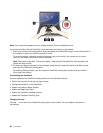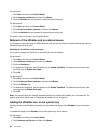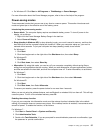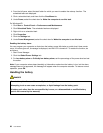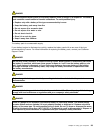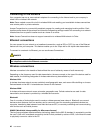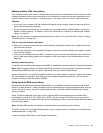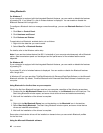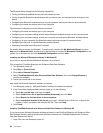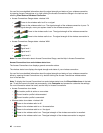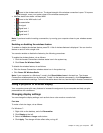
Connecting to the network
Your computer has one or more network adapters for connecting to the Internet and to your company's
wired LAN or wireless LAN network.
Note: Some models come with a built-in wireless WAN card enabling you to establish wireless connections
over remote public or private networks.
Access Connections is a connectivity assistant program for creating and managing location proles. Each
location prole stores all the network and Internet conguration settings needed for connecting to a network
infrastructure from a specic location such as a home or an ofce.
Note: Access Connections does not support connection to wireless WAN network in China.
Ethernet connections
You can connect to your network or a broadband connection, such as DSL or CATV, by use of the Ethernet
feature built into your computer. This feature enables you to do 1Gbps half or full duplex data transmission.
To connect to a network via Ethernet, you can use Access Connections.
DANGER
Your computer has an Ethernet connector. To avoid the risk of electrical shock, do not connect
the telephone cable to the Ethernet connector.
Wireless connections
Wireless connection is the transfer of data without the use of cables by means of radio waves only.
Depending on the frequency used for data transmission, the area covered, or the type of the device used for
data transfer, the following categories of wireless networks may be available to you:
Wireless LAN
A wireless local area network covers a relatively small geographic area, such as an ofce building or a house.
Devices based on the 802.11 standards can connect to this network.
Wireless WAN
A wireless wide area network covers a broader geographic area. Cellular networks are used for data
transmission, and access is provided by a wireless service carrier.
Bluetooth
One of a number of technologies used to create a wireless personal area network. Bluetooth can connect
devices a short distance from one another, and is commonly used for connecting peripheral devices to a
computer, transferring data between hand-held devices and PC, or remotely controlling and communicating
with devices such as mobile phones.
WiMAX (Worldwide Interoperability for Microwave Access)
This long-range wireless data transmission technology based on the 802.16 standard, is expected to provide
the user a “last mile” broadband connectivity similar to that provided by cable or ADSL, but without the need
to physically connect a cable to the PC.
40 User Guide



